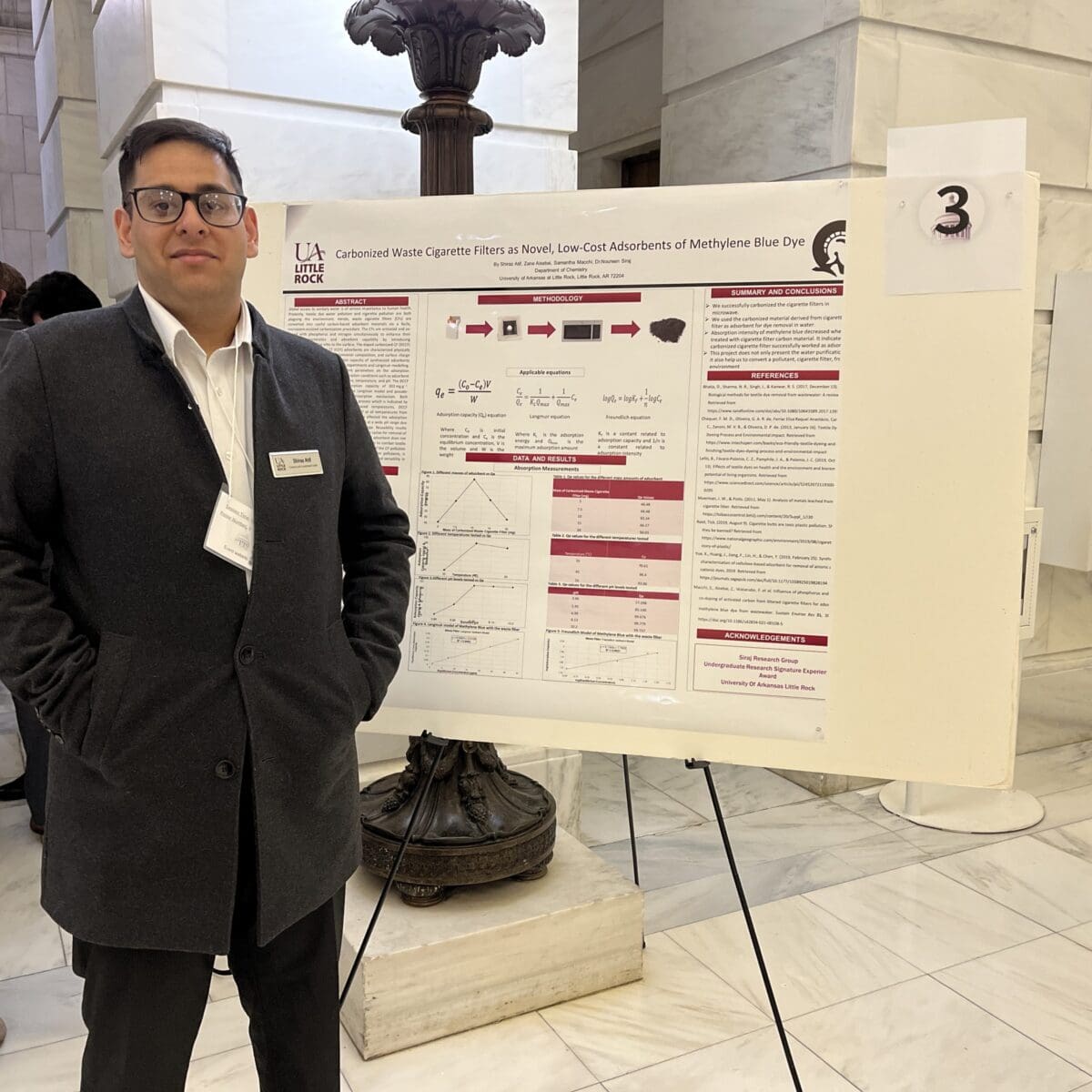UA Little Rock STEM Students Present Research at Arkansas State Capitol

Six UA Little Rock undergraduate students presented their research at the Arkansas State Capitol on Feb. 8.
The program, “Posters at the Capitol,” ran from 10:30 a.m. to 1 p.m., and the UA Little Rock students presented during the second block from Noon to 1:15 p.m.
Armin Mortazi, who studies Biology and Chemistry, was one of the six presenters. Mortazi’s team under Dr. Noureen Siraj developed research on an approach to combat multidrug-resistant bacteria that infect millions of people worldwide.
They used an ionic exchange method to synthesize an antibiotic and a dye. Dye absorbs heat, and when combined with the antibiotic, it creates a kind of combination therapy that showed promising results in their initial trials.
Mortazi presented this research at the capitol, where attendees included Representative Andrew Collins from his own home district, district 73. This event provided the students with an opportunity to expose and shine a light on their research.
“Our research has real-world implications, and I felt it was important to share it with someone who could take action to support it,” Mortazi said. “It was inspiring to see how much support and investment there is in scientific research and innovation, and it emphasized the importance of continued funding and resources.”
This was several students’ first experience presenting research of this magnitude, including chemistry student Shiraz Atif. For his project, Atif researched ways to eliminate the textile industry’s contribution to water pollution. He used carbonized waste cigarette filters– the largest pollutant globally– to remove the pollutant dye in the water, presenting a low-cost adsorbent that could alleviate water pollution and cigarette waste in the environment at the same time.
“I definitely had some hiccups, but after a while it all became second nature,” Atif said. “This project has taught me a lot, the most important being that teamwork and being on the same page is crucial for major projects like this. If it were not for Dr. Siraj, the graduate students, and the other undergraduate students that work under her, this project would still be in the planning phase.”
Research requires a lot of patience, and that’s something that these students had to learn when working on their respective projects. For Cecile Barnes, who is studying medical sciences, the research process was slow, but worth it in the end. In summer 2022, Barnes worked as an undergraduate student at University of Arkansas for Medical Sciences (UAMS) in the Biomedical Science building. Her mentor at the time, Dr. Eric Peterson, came up with the idea for her to research liver inflammation of rats exposed to methamphetamine and the drugs that could weaken the effects.
Barnes worked with pioglitazone (PIO), an anti-inflammatory that lessens the impact of METH-induced inflammation on the liver. The goal was to see a decrease in the rats’ inflammation through the help of PIO, and although Barnes was unable to develop conclusive results, the project is still ongoing in Dr. Peterson’s lab.
“There were times we believed it was going in the right direction just to have to turn around and trouble shoot more ideas to try,” Barnes said. “Medicine has always been a passion of mine, so getting to research, even though it’s not the field I plan on being in, was fun and insightful. Having this experience made me realize I want to explore clinical research either during or after I become a doctor.”
The presenters included:
- Shiraz Atif, Chemistry, “Carbonized Waste Cigarette Filters as Novel, Low-Cost Adsorbents of Methylene Blue Dye”
- Cecile Barnes, Medical Sciences, “Characterization of the effect of a PPAR-y Agonist on METH-induced inflammation in Rodent Hepatic Tissues”
- Arisha Ishtiaq, Chemistry, “Investigation of the mechanism of enhanced photothermal effect of combination ionic nanomedicines”
- Mikiya McAdory, Chemistry, “Studies in hydridic reduction of alkynyl hydrazones via sigmatropic rearrangement to form allenes”
- Armin Mortazi, Chemistry, “Combination Therapy Approach to Combat Multi-Drug Resistant Bacteria”
- Licheng Xu, Ilhamm Kadhim, Nazneen Begum, and William King, Biology, “Up-regulation of Osh6 prolongs the G2 phase of the cell cycle”
